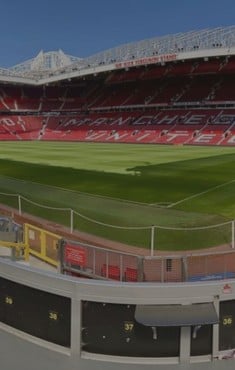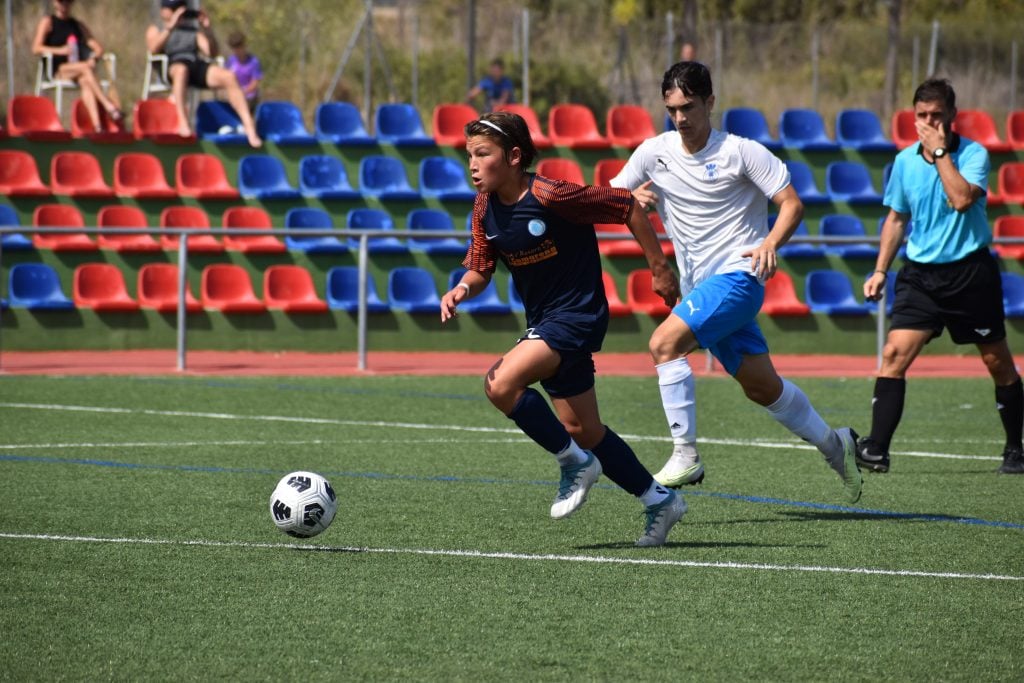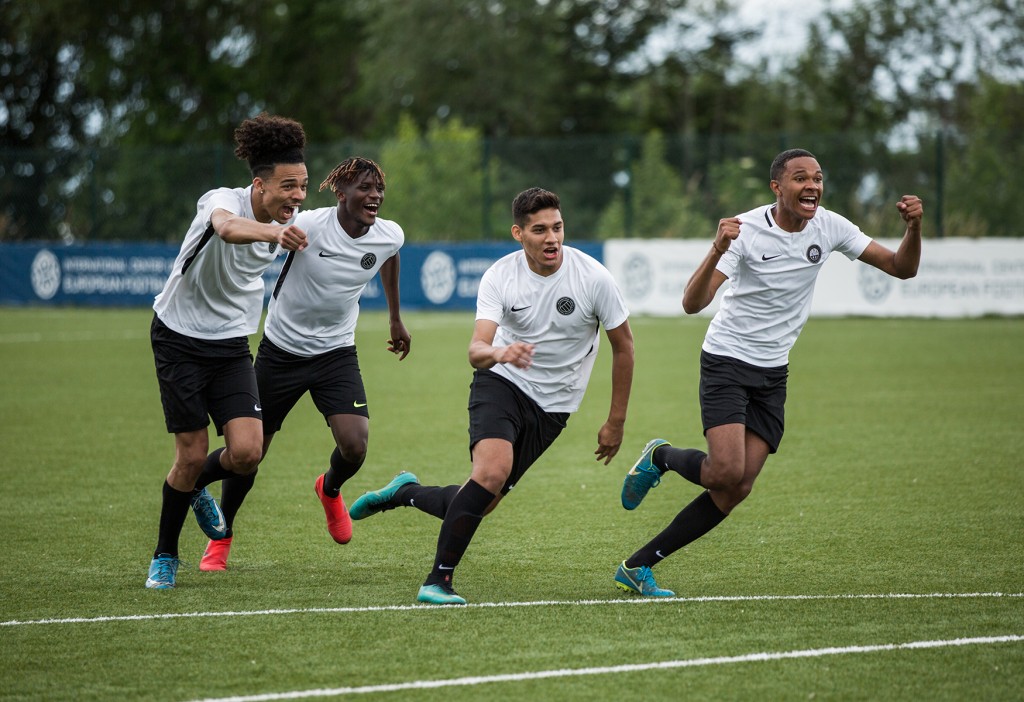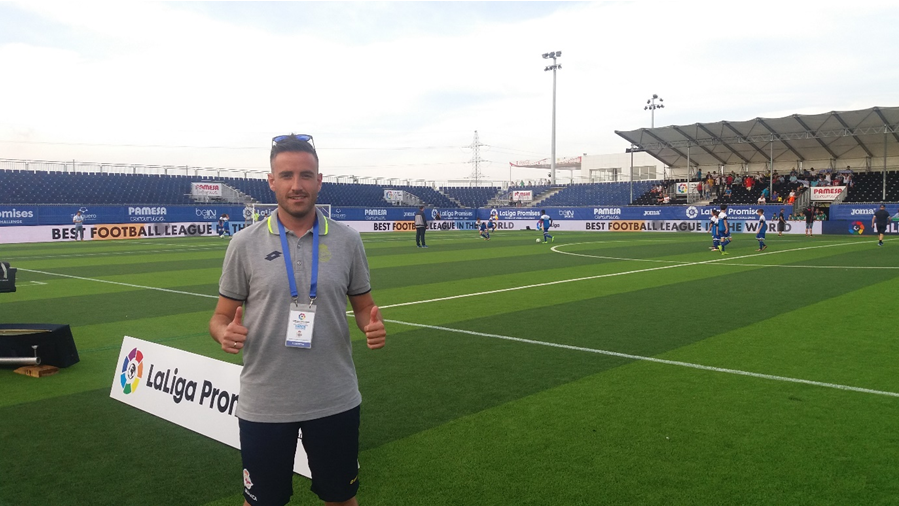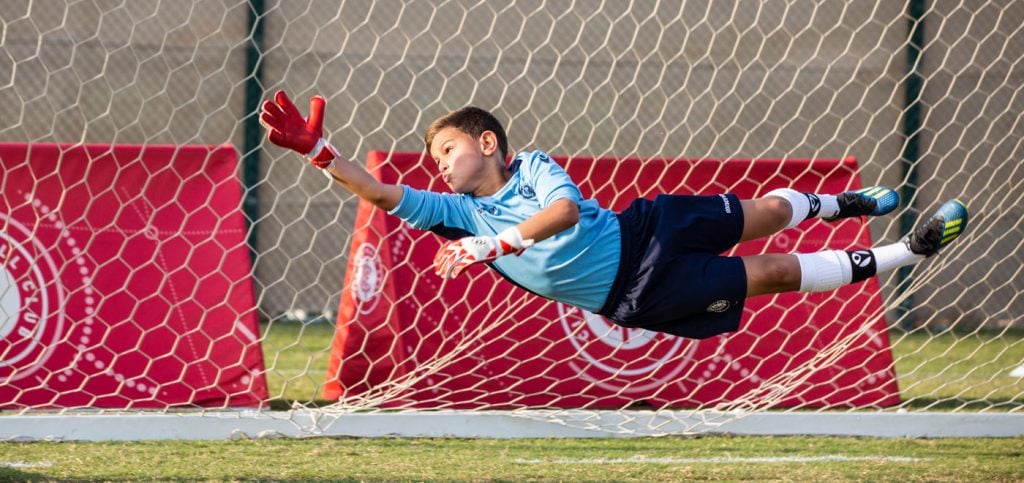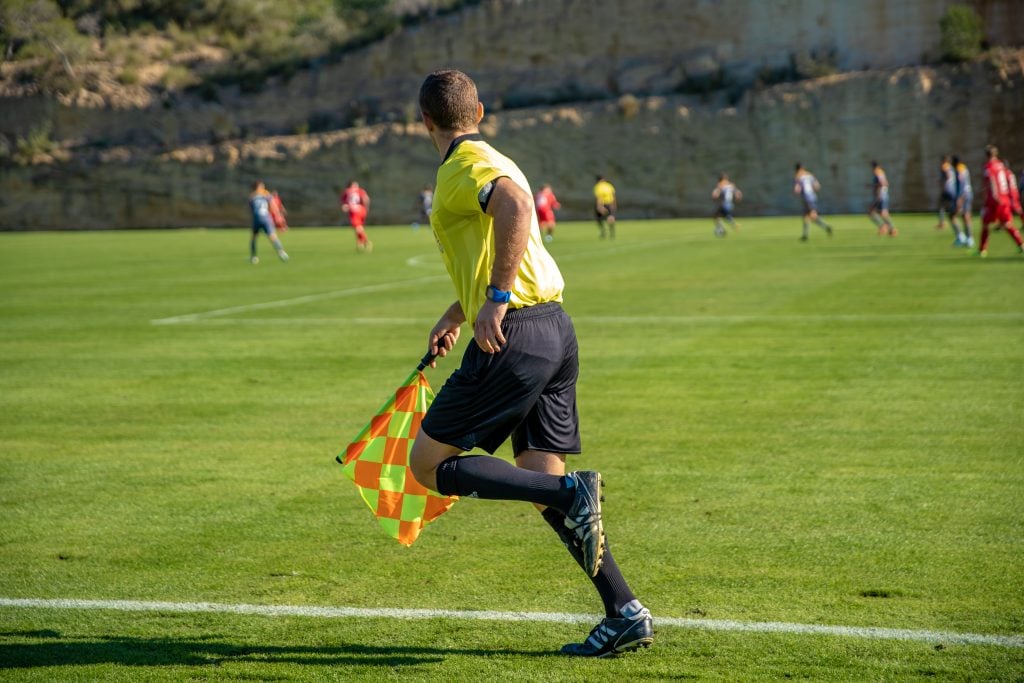English soccer isn’t only known for its excitement in the top leagues, such as the Premier League, but also for its strong grassroots development structure. Understanding the age groups and the ways it all divides up is essential for any aspiring footballer, their parents, and fans of the sport.
In this article, we’ll take an in-depth look at the different levels and categories in English soccer, from the youngest ages right through to the elite, giving you a complete overview of the structure that has produced some of the most outstanding talents in world soccer.
Soccer Levels Classified by Age – English Soccer Levels
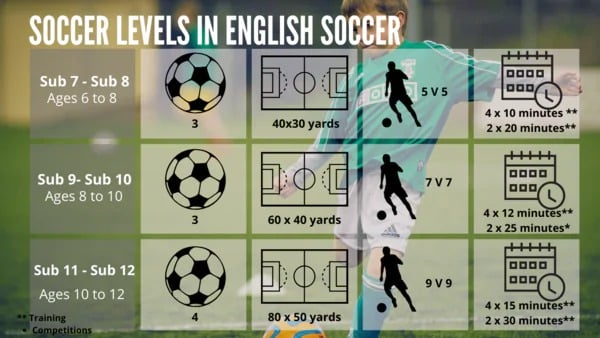
The English soccer age categories are divided as follows:
Mini Soccer – U7 y U8 Levels
The first of these children’s soccer categories, aimed at 6 to 8-year-olds, offers a truly unique playing experience. Children don’t participate in regular leagues, but, rather, in up to three trophy events per season, promoting fun and learning. The pitches measure 40 x 30 yards for 5v5 matches, with size 3 balls for safety. The children wear shin guards, but can’t wear hooded sweatshirts. Players must wear shirt colors that differ from their own team’s, encouraging diversity and fair play.
U9 and U10 Levels
In the U9 and U10 soccer levels, children aged 8-10 participate in 7v7 soccer matches on 60×40 yard pitches with size 3 balls. They have the chance to compete in three 4-week trophy events throughout the season, which helps teach them about competition and fair play. These English soccer categories emphasize fun and learning, while introducing the children to a slightly more competitive and advanced level of play.
U11 and U12 Levels
In the U11 and U12 youth soccer categories, 10 to 12-year-olds play 9 against 9 on 80×50-yard pitches. The matches are 30 minutes each way, with each child only allowed to play a maximum of 80 minutes a day and 120 minutes per competition. Safety is strongly enforced with shin pads and size 4 balls, as well as roll-off roll-on substitutions being permitted with the referee’s approval. In addition to these regular competitions, the children take part in six-week trophy events three times a season, which encourage skill development in a competitive and stimulating environment.
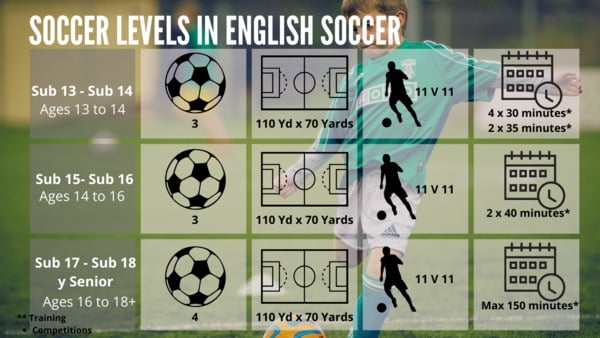
U13 and U14 Levels
In this level of English youth soccer, the U13 and U14 levels play in an 11v11 format on 100×60-yard pitches, with matches lasting 35 minutes per half. Children can only play a maximum of 100 minutes per day and 150 minutes per competition; shin pads and size 4 balls are mandatory. Roll-off roll-on substitutions are also allowed with the referee’s approval. The focus is on safety and skill development in a challenging environment.
U15 and U16 Levels
This age group plays in an 11v11 format, with games of 40 minutes each way on 110×70-yard pitches. Individual players can only play up to 100 minutes a day and 150 minutes per competition. Roll-off roll-on substitutions are permitted with referee approval. The use of essential equipment, such as shin pads and size 5 balls, is enforced, as well as proper clothing, including team kits, shin pads, and recommended footwear. This is all necessary in order to ensure safety and compliance with the rules.
U17, U18, and Senior Levels
England’s U17, U18, and Senior soccer levels offer an exciting standard of competition in 11v11 matches on a 110×70-yard pitch. Players are limited to 120 minutes of playing time per day and 180 minutes per competition. Roll-off roll-on substitutions are allowed with referee approval. Mandatory equipment includes shin pads and size 5 balls. The boots must be suitable for the playing surface, and hooded sweatshirts are prohibited during matches.
English Soccer Divisions
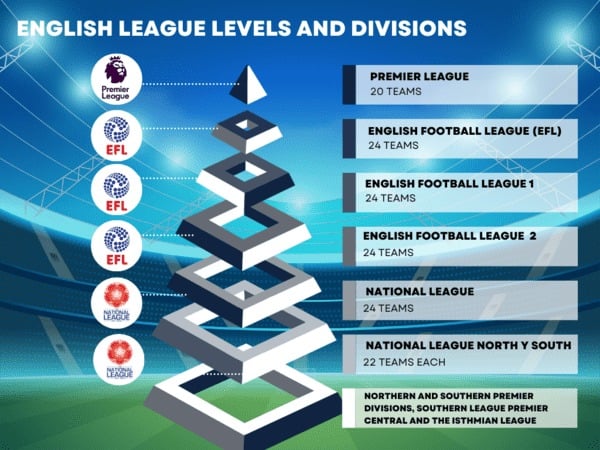
Premier League – The Top Level
At the pinnacle of the English soccer pyramid we find the Premier League, the country’s highest level. With 20 teams competing in an exciting round-robin format, the top teams qualify for the different European competitions while the bottom three are relegated to the Championship. Manchester United is the current leader in terms of titles. For this reason, a summer camp in Manchester with the cream of the crop is an excellent way to experience English soccer.
English Football League (EFL) – The Second Level
The EFL, or the Championship, has been the second division of English football since 2004. It features 24 teams, with the top two teams automatically promoted to the Premier League. The next four teams compete in some exciting play-offs to fight for the third promotion spot, with memorable finishes such as Troy Deeney’s goal in 2018.
EFL 1 – Third Level & EFL 2 – Fourth Level
League One of the EFL is the third level in English football, with a total of 24 teams competing. The top two are promoted to the Championship, and the next four play off for the third promotion spot. The bottom four are relegated to EFL 2. League Two of the EFL is the fourth level, and also has 24 teams, with the top 2 promoted to League One and the bottom four relegated to the National League. Both leagues are crucial to the development of English soccer.
The National League – the Fifth Level
The National League, a semi-professional league, is the fifth tier in English soccer. It is made up of 24 teams, where the champion is automatically promoted, and the next six teams compete in playoffs for the second promotion spot. The bottom four teams are relegated to the North or South divisions.
National Leagues North and South – the Sixth Level
The National League North and South divisions are geographically divided, with 22 soccer teams in each. They provide intense competition at a regional level, fueling local rivalries and encouraging skill development. The winners of both divisions are promoted to the English National League, with the next six competing in playoffs for the second promotion spot – a total of four promoted teams. The bottom four in each division are relegated. If there aren’t the same number of teams in both divisions due to promotion or relegation, then “transfers” are made to even them up.
Northern and Southern Premier Divisions, Southern League Premier Central and the Isthmian League – Seventh Level
Divisions at this level are instrumental in connecting amateur and professional soccer. Regional teams compete for supremacy and the possibility of advancing in the soccer hierarchy. Four soccer leagues run simultaneously: the Northern Premier League Division, the Southern Football League Premier Central, the Southern Football League Premier South, and the Isthmian League Premier Division. Each league has 22 teams competing for the title and promotion.
The Different Levels in English Women’s Football
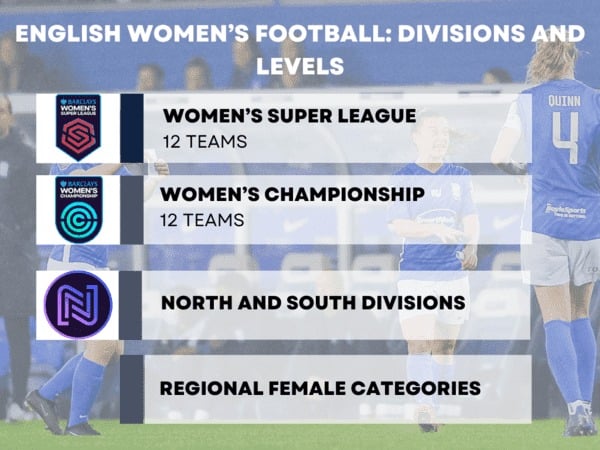
Women’s Super League (WSL) – First Level
The Women’s Super League (WSL) is the top tier of women’s football in England, which showcases the growth and success of the sport. It is made up of 12 teams seeking to become champions and also to compete in the UEFA Champions League.
Women’s Championship – Second Level
The teams in this league compete for promotion to the WSL, providing players with opportunities for development and recognition. It was created in 2014 under the name of the FA Women’s Super League 2 (WSL 2). It is governed by the FA, and is currently made up of 12 teams. The champion and runner-up are promoted to the WSL.
FA Women’s National League: North and South Divisions – Third Level
A key platform for up-and-coming players, the FA Women’s National League encourages growth and competitiveness in the women’s game.
Regional Female Categories – Fourth Level
At a regional level, these categories nurture talent as players move towards higher levels, supporting and fostering the long-term development of the women’s game.
The Importance of Developing Talent
The grassroots soccer programs play a crucial role in the development of young football players. Apart from technical and tactical enhancement, values such as discipline, work ethic, and respect are instilled into them.
Club training at youth level is essential in order to hone and develop skills and provide a structure that can encourage growth. Clubs such as Manchester United, Arsenal, and Liverpool have consistently demonstrated strong talent development frameworks, producing world-class players such as Cristiano Ronaldo, Jack Wilshere and Steven Gerrard.
Player Evaluation and Recruitment in English Soccer
The evaluation and recruitment of players at the grassroots level is a meticulous process. They don’t only look for technical skills, but also for attributes such as a competitive mentality, the ability to work as part of a team, and resilience under pressure.
Clubs use Soccer Trials (or Tryouts) to identify and nurture future talent. This careful selection process is crucial in ensuring that players can progress to higher levels.
Competitions and Tournaments at Grassroots Levels
Youth soccer in England has some major competitions and tournaments that can really help young players to develop. The FA Youth Cup and the EFL Trophy are showcases for young talent, giving them the chance to shine and progress in their careers. These events aren’t only crucial for a player’s technical development, but will also nurture the competitive mindset required in professional soccer.
Top Competitions and Tournaments in English Youth Football
Some of the main competitions and tournaments in the English youth soccer categories include:
- The FA Youth Cup attracts youth teams from all over the country. Renowned clubs such as Manchester United, Chelsea, and Liverpool have used this tournament as a platform to showcase their up-and-coming young talent.
- EFL Trophy: This tournament includes youth clubs from the Premier League. It gives young players the chance to compete on a national stage against more experienced opponents, creating an invaluable learning environment.
Contributing to the Growth of Young Football Players
These events aren’t just about victories and defeats; they’re pivotal in the development of young soccer players. Competing at such high levels early in their careers builds resilience, resolve, and adaptability. On top of that, being exposed to different styles of play and tactics will broaden their understanding of the sport. The tournament formats often replicate professional soccer scenarios, thus providing players with true-to-life experiences.
Some Successful Soccer Players that Emerged from Grassroots Soccer

Countless world-class players have started out at grassroots level. As we can see from these examples, grassroots soccer doesn’t only develop technical skills, but also the strong work ethic and mentality that are key to success at the game’s elite level:
- Wayne Rooney, whose first steps in Everton’s youth ranks propelled him to become England’s all-time leading goalscorer.
- Marcus Rashford, who rose through Manchester United’s youth academy to become an outstanding striker as well as an influential presence off the field.
Challenges and Opportunities in Youth Football in England
The road to the upper echelon isn’t without its challenges. Young players face intense competition, where the pressure to excel can be overwhelming. Injuries are also a common impediment, and mental and physical resilience is tested right from the earliest levels.
In addition, moving to higher levels brings with it increased expectations and the need to adapt to more complex playing styles. Striking a balance between education and soccer is another challenge for many aspiring young players.
Advancement Opportunities and the Importance of High Performance
Despite these challenges, youth soccer in England offers unique opportunities for a player to progress to higher levels. Elite clubs often keep a close eye on young talent, and standout performances in competitions such as the FA Youth Cup can unlock opportunities for professional contracts.
The importance of a player’s overall performance is undeniable. Coaches don’t only evaluate technical ability, but also the player’s mindset, work ethic, and the ability to cope with high-pressure situations. Players who show consistency and a winning mentality are often the ones who advance to the elite levels.
Inspiring Stories of Players who Rose from the Youth Ranks to the Elite
Throughout its history, English football has seen inspirational stories of players rising from the youth ranks to the elite. The legendary goalscorer Alan Shearer started at youth level at Southampton before becoming the Premier League’s top scorer.
Jamie Vardy’s journey is another inspirational story. He started out playing at non-professional levels, but quickly rose through the ranks and played a crucial role in Leicester City’s historic Premier League win in the 2015-2016 season.
These stories stand as a reminder that, even in the fiercely competitive world of youth football, perseverance and dedication can indeed pave the way to success.
Conclusion
Youth soccer in England is a vibrant breeding ground that both nurtures and cultivates talent. Competitions and tournaments such as the FA Youth Cup and the EFL Trophy are the testing grounds where future stars are shaped. The challenges faced at each level and the opportunities for advancement are an intrinsic part of the journey.
The many inspiring stories of players who have overcome hurdles to reach the elite highlight the importance of these competitions in the development of complete footballers. At the end of the day, youth soccer isn’t only the breeding ground for talent, but it’s also the foundation on which the exciting game of English soccer is built.

